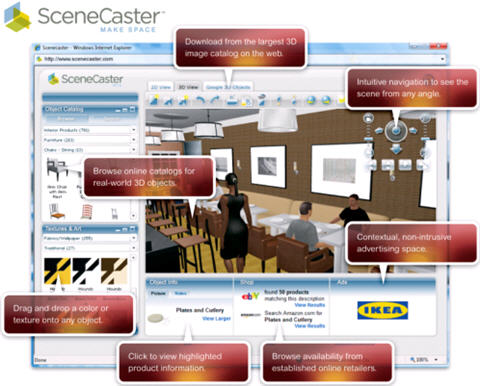SceneCaster: 3D media creation and sharing for the masses

At this point 3D hasn't been a mainstream part of the social Web, mostly confined to virtual reality environments like Second Life. SceneCaster, which will debut at DEMOfall 07 this week, takes the concept that Flickr and YouTube has done well--Web 2.0 media sharing in a browser--and applies it to 3D scenes in a browser. The free service, which requires a download, allows users to create, share, tag, and collaborate on scenes, as well as to transform existing 3D scenes.
We call it 'user modified' content, said Mark Zohar, founder and senior vice president of SceneCaster. "We are not a virtual world like Second Life, but more like social media." Zohar said the goal is to create more of a mass market for 3D content.
SceneCaster is integrated with Google's 3D Warehouse and includes other catalogs of 3D objects, and supports various 3D formats. It allows users to share scenes via Flickr and to modify and create new scenes from within Facebook. It also has a click to ecommerce component, with eBay and Amazon results for objects that appear in a scene. For example, select a chair object and ecommerce results matching the description are shown in a separate browser window. Zohar expects eBay sellers and others to create 3D Web showrooms, product catalogs and storefronts.
Users can 'favorite' objects as well, and export scenes in other 3D formats, Google Earth, Flash and blog platforms. Objects can have some intelligence via metadata that defines behaviors within a scene. The technology is based on parent company View 22's Immersiv 3D Web platform, and currently only runs on Windows systems.
I asked Zohar what would motivate people to create 3D scenes, to create a mass market for 3D content, even if the majority of users are 'looker,' not creators. It's not as simple or mass market a taking photos or videos and uploading them to the dozens of media sharing, tag friendly, social networking services. In addition, SceneCaster is eschewing any kind of virtual currency or goods exchange for now.
The initial audience is the 3D creators and Google SketchUp audience--those who create content that can live in SceneCaster. The second wave will be visual artists, who will partake of the latest form of Web-based digital art. Thirdly, Zohar said the company is targeting utilitarian users--decorators, remodelers and rennovators. For example, SceneCaster is working with the American Society of Interior Designers.
SceneCaster expects to generate revenue from contextual ads, brand advertising (such as product placement in scenes), sponsorships and transaction revenue from ecommerce. For starters, SceneCaster has lined up partners, such as Commission Junction, eBates, Kohler, iStockPhoto, SmartFurniture.com, Wolfgang's Vault and ZeroFootprint. The company is also considering licensing its platform to other vendors.
SceneCaster is well conceived as a collaborative environment and an ecosystem for 3D content. Future enhancements will include turning photos into 3D scenes, and providing price quotes, rendering and bill of materials for scenes, Zohar said. It will be interesting to see if SceneCaster can raise the quantity and quality of 3D content, matching what sites like Flickr and YouTube have done for photo and video content.
